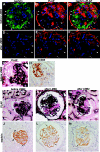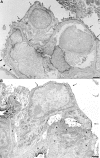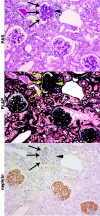Podocyte injury damages other podocytes
- PMID: 21719786
- PMCID: PMC3137575
- DOI: 10.1681/ASN.2010090963
Podocyte injury damages other podocytes
Abstract
Loss of podocytes promotes glomerulosclerosis, but whether this results from a continued primary insult or a secondary mechanism triggered by the initial loss of podocytes is unknown. We generated chimeric mice in which only a subpopulation of podocytes expressed hCD25, which is the receptor for the immunotoxin LMB2. In addition, genetic labeling of hCD25-negative cells with human placental alkaline phosphatase allowed the study of these two distinct podocyte populations. Administration of LMB2 did not cause podocyte injury in hCD25-negative control mice. In contrast, LMB2 severely damaged or sloughed off the subpopulation of hCD25-positive podocytes within the chimeric glomeruli. Moreover, hCD25-negative podocytes, which were immune to the initial toxin injury, developed injury as early as 4 d after LMB2 injection, evidenced by foot process effacement, upregulation of desmin, and downregulation of nephrin, podocin, and podocalyxin. Furthermore, the magnitude of secondary injury correlated with the magnitude of primary injury, supporting the concept of an amplified cascade of podocyte injury. In conclusion, podocyte damage can propagate injury by triggering secondary damage of "remnant" intact podocytes, even when the primary insult is short-lived. This transmission of podocyte injury may form a vicious cycle leading to accelerated podocyte deterioration and glomerulosclerosis.
Copyright © 2011 by the American Society of Nephrology
Figures







Comment in
-
Podocyte injury can be catching.J Am Soc Nephrol. 2011 Jul;22(7):1181-3. doi: 10.1681/ASN.2011050486. Epub 2011 Jun 16. J Am Soc Nephrol. 2011. PMID: 21680648 No abstract available.
Similar articles
-
Indirect podocyte injury manifested in a partial podocytectomy mouse model.Am J Physiol Renal Physiol. 2021 May 1;320(5):F922-F933. doi: 10.1152/ajprenal.00602.2020. Epub 2021 Mar 15. Am J Physiol Renal Physiol. 2021. PMID: 33719575 Free PMC article.
-
Mice are unable to endogenously regenerate podocytes during the repair of immunotoxin-induced glomerular injury.Nephrol Dial Transplant. 2014 May;29(5):1005-12. doi: 10.1093/ndt/gft413. Epub 2013 Dec 8. Nephrol Dial Transplant. 2014. PMID: 24322577
-
Rapid downregulation of beta-actin-based CAG promoter and filamentous actin in injured podocytes.J Med Dent Sci. 2005 Jun;52(2):129-34. J Med Dent Sci. 2005. PMID: 16189885
-
Podocyte mitosis - a catastrophe.Curr Mol Med. 2013 Jan;13(1):13-23. doi: 10.2174/1566524011307010013. Curr Mol Med. 2013. PMID: 23176147 Free PMC article. Review.
-
[The role of podocyte damage in the pathogenesis of glomerulosclerosis and possible repair mechanisms].G Ital Nefrol. 2009 Nov-Dec;26(6):660-9. G Ital Nefrol. 2009. PMID: 19918748 Review. Italian.
Cited by
-
Alport syndrome--insights from basic and clinical research.Nat Rev Nephrol. 2013 Mar;9(3):170-8. doi: 10.1038/nrneph.2012.259. Epub 2012 Nov 20. Nat Rev Nephrol. 2013. PMID: 23165304 Review.
-
Global polysome analysis of normal and injured podocytes.Am J Physiol Renal Physiol. 2019 Feb 1;316(2):F241-F252. doi: 10.1152/ajprenal.00115.2018. Epub 2018 Oct 31. Am J Physiol Renal Physiol. 2019. PMID: 30379099 Free PMC article.
-
Intravital imaging of podocyte calcium in glomerular injury and disease.J Clin Invest. 2014 May;124(5):2050-8. doi: 10.1172/JCI71702. Epub 2014 Apr 8. J Clin Invest. 2014. PMID: 24713653 Free PMC article.
-
Following specific podocyte injury captopril protects against progressive long term renal damage.F1000Res. 2015 Jun 29;4:172. doi: 10.12688/f1000research.4030.1. eCollection 2015. F1000Res. 2015. PMID: 26629332 Free PMC article.
-
Triptolide Attenuates Podocyte Injury by Regulating Expression of miRNA-344b-3p and miRNA-30b-3p in Rats with Adriamycin-Induced Nephropathy.Evid Based Complement Alternat Med. 2015;2015:107814. doi: 10.1155/2015/107814. Epub 2015 May 20. Evid Based Complement Alternat Med. 2015. PMID: 26078766 Free PMC article.
References
-
- LeHir M, Kriz W: New insights into structural patterns encountered in glomerulosclerosis. Curr Opin Nephrol Hypertens 16: 184–191, 2007 - PubMed
-
- D'Agati VD: Podocyte injury in focal segmental glomerulosclerosis: Lessons from animal models (a play in five acts). Kidney Int 73: 399–406, 2008 - PubMed
-
- Wiggins RC: The spectrum of podocytopathies: A unifying view of glomerular diseases. Kidney Int 71: 1205–1214, 2007 - PubMed
-
- Barisoni L, Schnaper HW, Kopp JB: A proposed taxonomy for the podocytopathies: A reassessment of the primary nephrotic diseases. Clin J Am Soc Nephrol 2: 529–542, 2007 - PubMed
-
- Mundel P, Shankland SJ: Podocyte biology and response to injury. J Am Soc Nephrol 13: 3005–3015, 2002 - PubMed
Publication types
MeSH terms
Substances
Grants and funding
LinkOut - more resources
Full Text Sources
Other Literature Sources

